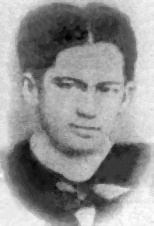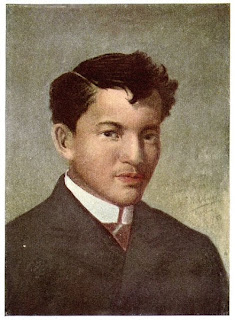 Image via Wikipedia
Image via WikipediaJosé Rizal, the Philippine National hero was once a teen-ager. The attributes of a teen is that one day they act goofy, the next, they act mature. One day they are full of pranks, the next they are full of seriousness. Often they are sentimental, at the same breath they are rational.
Ladies and gentleman, allow me to present to you Jose Rizal, the teen ager.
The first picture above is available on Wikipedia. He is 18 years old, then a pre-med student at the University of Santo Tomas, where he made a name for himself by being a serious student, having won numerous prizes in arts and letters. Rizal made a sketch himself. It was a picture of a young man, a teen.
He went to Europe in 1882 when he was 20. He was gregarious as a post-teen ager, traveling alone first class, on a steamship bound for Europe for the first time.
He touched Spanish soil (Barcelona) first week of June. As a young adult, he was full of himself. At the Fonda de España (inn) in Barcelona, he disdained its shabbiness, comparing his privileged life in Calamba with all the landed gentry amenities. At this time, he immediately went to work. He submitted an article published in Diariong Tagalog. It was a treatise on patriotism.
He ran out of money and went to the Jesuit college where he presented letters of introduction. Here he roomed with old and retired Jesuit priests. He begins his teen age characteristics again by making opinionated statements like "the old priests were speaking a "rude" language." It never occurred to him they were speaking in Catalan. He was of course comparing the Catalan language to the flowery and smooth style of the Castillian language that he learned to perfection. He was 20 going on 30 at that time.
He proceeded to Madrid in September. Now he had reached the ripe old age of 21. He joined the Circulo Hispano-Filipino, whose members were Filipino students studying in Madrid including a few Spaniards who were born in the Philippines--the Insulares.
In self-righteousness, he dissolved the Club's newsletter because the submission deadlines were never met. He forbade his friends to gamble away their time in ""useless" card games. In a spirit of prank, he conferred on his room mate, Vicente Gonzalez, (an old classmate from Ateneo de Manila days) the monicker: Marquis de Pagong (Marquis, The Turtle). Vicente was just being Hispanized, staying late for dinner up to the wee hours of the morning and of course would be sluggish, while Rizal would be up at 5:30 in the morning, bright and spanky.
He met Felix Resurreccion Hidalgo, the painter. He sat for an oil painting. It is the 2nd picture above. Resurreccion captured the teen-aged José Rizal. Felix is the consummate interpreter of character nuances. This is my favorite Rizal portrait....impish, rakish grin, tousled hair--which he tidies most of the time--off-skilted tie, twinkling eyes as if contemplating on doing something silly: in general, of being such a charming teen-age matinee idol.
Felix brought this oil painting to Manila and presented it to Don Antonio Rivera, Rizal's uncle and Leonora Rivera's father. Visitors came to admire the artist's signature, not the image. It was after all signed by a Resurreccion. Paciano actually glossed it over. Only later, when viewing from afar, that the resemblance to his own brother struck him. Paciano had actually forgotten the image of a young teen-ager. All this time, he was projecting the aura of Jose Rizal as a Europeanized medieval gentleman: the ilustrado: upright and proper (in his cuerpo (Rizal never wore an overcoat, but was dressed in the impeccable European style frock coat).
The artist in his painterly manner, gave us the humanized young essence of Rizal seldom brought out by our Rizalist scholars who want to present to us an intellectualized Rizal forgetting that like our own teen-aged offsprings and sibings, he too went through the process of teen-aged ambivalence as he was training to be the Great Hero that he had become.
x
Stay with me in my next blog where I present José Rizal in Madrid as The Ma-pintasin: The critic.


No comments:
Post a Comment